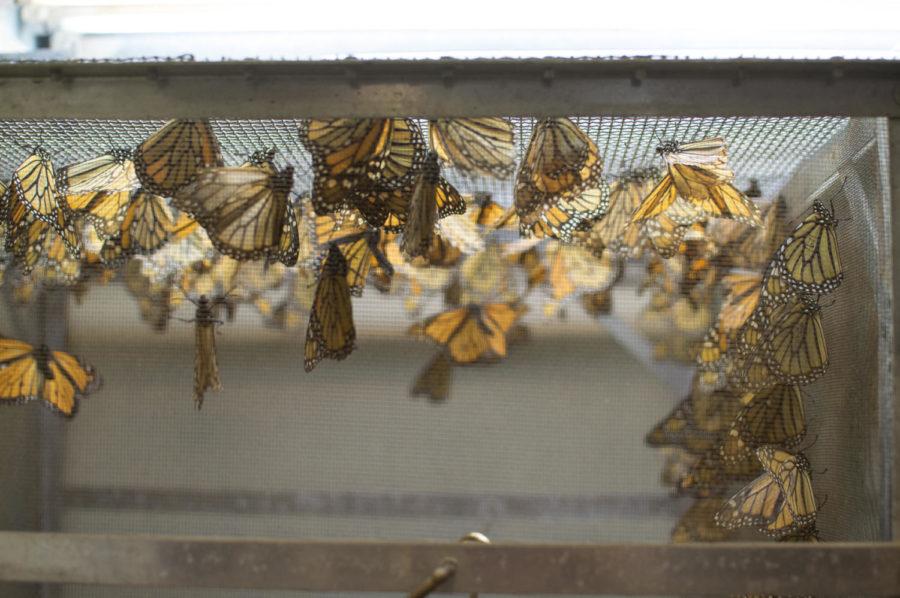New initiative aims to save butterflies
Monarch butterflies are watched at Iowa State University in the Genetics Laboratory. Iowa State is participating in a monarch conservation effort alongside the U.S. Agricultural Research Service.
October 8, 2015
Could you walk 2,500 miles twice a year?
Each year the monarch butterfly migrates about 2,500 miles through the heart of North America. Iowa sits in the middle of the monarch’s path as they travel to their winter home from their summer habitat in Canada.
State and government officials have recently noticed a drastic decline in the number of monarchs wintering in Mexico each year.
“Counting monarchs in Mexico is a very interesting process,” said Sue Blodgett, professor of entomology. “When the monarch overwinters in Mexico they rest in the trees, turning the trees orange. We measure the population in hectares, so whoever is measuring the population will fly over their habitat and count the number of hectares that the monarch is covering.”
Blodgett said four to six hectares are needed for a sustainable population. One hectare equals 100 acres.
Monarchs covered about one hectare in 2014. This is one of the lowest number of hectares to be recorded since 2003, the start of the most recent decline.
“There are a lot of reasons [for the decline],” said Steven Bradbury, professor of natural resource ecology and management. “Deforestation in their wintering habitats in Mexico, urbanization and a loss of milkweed and other feeding plants are a few of the main causes.”
This loss has caused a statewide consortium to be formed in Iowa to help keep monarch population numbers from dropping lower.
The Iowa Monarch Conservation Consortium was started in spring 2014 and has been gaining members ever since. Members are joining rapidly enough that Bradbury said the consortium couldn’t even keep its website up to date.
When the consortium was being created, Bradbury said members were remembering what it was like when they were growing up, being able to witness the mass migration of the monarchs.
“The [consortium] came together, in part, by what the monarch represents,” Bradbury said. “In Iowa and surrounding states, people have personal experience with [the monarch]. It represents a lot of values about conservation and natural resources.”
The ISU College of Agriculture and Life Sciences is partnered with many government agencies in the consortium, including the Iowa Department of Agriculture and Land Stewardship, the Iowa Department of Natural Resources and the U.S. Fish and Wildlife Service.
“The goal of the consortium is to help develop and implement approaches to increasing breeding habitats for monarchs,” Bradbury said.
To aid in the research, Secretary of Agriculture Tom Vilsack awarded $760,897 to the consortium. According to the U.S. Department of Agriculture, this money comes out of a country-wide Conservation Innovation Grant awarded by the USDA to help with conservation practices.
“This year’s slate of projects represent the next generation of natural resources conservation, headed by partners who are progressive and forward-thinking in their solutions to natural resource problems,” Vilsack said in a press release announcing the grant. “Many of them are also engaging with … our under-served farmers and ranchers, and carrying their projects into parts of the country where Conservation Innovation Grants have not been utilized in years past.”
To help aid in the monarch migration, the consortium wants to increase the number of milkweed plants along the path and decrease the distance in between plants. Members will monitor the monarch populations as they migrate through Iowa and will examine how increased habitat will affect the monarch population, Bradbury said.
To find the best possible solution for the migration problem, the consortium has planted nine different species of milkweed at 13 research farms located around Iowa.
“We are not introducing any new species to Iowa that would be bad,” Blodgett said. “What we are doing is testing to see if certain milkweed species grow better in certain parts of Iowa, and if the monarchs prefer a certain species.”
The consortium will also monitor the spread of the plants to insure that none of them present weed problems. No one will want to plant the milkweed in his or her yard or in public places if the plant becomes a problem, Blodgett said.
Blodgett said other states have been looking at what the consortium is doing. She said the other states might adapt to the model of the consortium for their own monarch conservation.
The consortium has also taken the lead with a monarch symposium in Minneapolis, Minn., this winter. The symposium will allow other people conducting monarch research to share what they have found.
“We don’t want to reinvent the wheel,” Blodgett said. “We can save years of research by just hearing what people in other states have found in their research.”
With migration season getting closer, Blodgett has already noticed the different species of milkweed have different effects on the migration of the monarchs. It’s too early to say what those differences mean, but Blodgett is confident in the work the consortium is doing.
“It’s good to be conscience of the reasons [for the monarch decline],” Blodgett said. “We can’t unplant houses, so we have to look at where we are today. We have limited resources, so we have to try and maximize these sources. At the end of the day, we are hoping that our research will help better inform efforts to help monarchs.”







